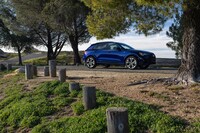One of the things compact, luxury-brand crossovers like the Audi Q3 have in common with other, otherwise similar small crossovers from other (non-luxury) brands such as Mazda, Hyundai and Kia is that they're all very similar.
That's a problem when you're a luxury brand and wanting to sell more or less the same thing for more money.
What It Is
The Q3 is Audi's entry-level and smallest crossover. It is very similar to other small crossovers in its class and also to other small crossovers that aren't in the luxury-brand class, such as the Mazda CX-30.
The Q3 is 176.6 inches long and comes standard with a turbocharged, 2.0-liter four-cylinder engine that makes 228 horsepower paired with an eight-speed automatic and standard all-wheel drive. Base price for the Premium trim is $39,800. This trim also comes standard with an LCD display instrument panel, a power rear liftgate, LED headlights, a panorama sunroof, heated leather seats and a 10-speaker audio system.
A top-of-the-line Premium Plus trim — which comes with a larger (LCD) instrument panel and a 15-speaker premium audio system — stickers for $42,600.
As a point of comparison, a Mazda CX-30 Turbo is about the same size, comes standard with a larger (2.5-liter) turbocharged four that touts 250 horsepower, a six-speed automatic and standard AWD. It also comes standard with heated — but not leather-covered — front seats and an eight-speaker stereo. It doesn't have an LCD display instrument panel, but it does come with an LCD secondary touch screen.
The chief difference is the Mazda's price: $33,140 — which is $6,660 less.
What's New
Audi has nixed the previously available (and lower cost) base trim, which means that buying this small, luxury-brand crossover just got pricier.
What's Good
— Standard turbocharged drivetrain delivers good power/performance.
— Compact on the outside but roomy on the inside (including 48 cubic feet of available cargo space with the second row folded forward).
— Luxurious-looking (and feeling) interior.
What's Not So Good
— You could buy a Mazda CX-30 with a stronger turbocharged engine that delivers better performance and pay nearly $7,000 less for it.
— Other small, non-luxury brand crossovers like the CX-30 have comparable space inside for people and cargo.
— A well-optioned non-luxury-brand small crossover such as the CX-30 also has a luxurious-looking (and luxurious-feeling) interior.
Under the Hood
Every Q3 comes standard with what is increasingly common — in all crossovers. That being a turbocharged 2.0-liter four-cylinder engine. This type of engine has proliferated because of compliance pressures; i.e., it is a type (and size) of engine small enough to not use too much gas — and so help a vehicle manufacturer comply with federal corporate average fuel economy and emissions standards — yet just large enough to make power and deliver performance enough to satisfy most buyers.
The problem — for a luxury car brand such as Audi — is that other compact crossovers without the luxury badge (and price to go with it) also have 2.0-liter fours. The just-updated 2025 VW Tiguan, for one. It's not quite as powerful a 2.0-liter four — 201 horsepower versus 228 horsepower for the Q3's 2.0 four — but you're also looking at spending just $30,245 to get it. Or you could spend a little more — $33,190 — to get into the Mazda CX-30 mentioned earlier and get a 2.5-liter four that makes 250 horsepower.
You see the problem ... for Audi.
Performance is another one. The Q3 takes a little over seven seconds to get to 60 mph, which isn't slow but also isn't very quick, relative to much less expensive small crossovers such as the CX-30 Turbo that can make the same run in about six seconds.
Gas mileage — 20 mpg city/28 mpg highway — is less than you might expect from a small crossover with such a small engine, but the Q3 is very heavy (3,902 pounds) for what it is.
An eight-speed automatic and AWD are standard with all Q3s.
On the Road
The Q3 is — like most crossovers — easy and pleasant to drive. Therein lies the rub.
What makes the Q3 stand out from the others?
Well, there is one thing, and it's not a small thing. The Q3's greenhouse — the industry term for its glass area — is more expansive than some of the others, including the Mazda CX-30's. Put another way, the visibility you get from inside the Q3 of the world outside is very good, and that's both pleasant and safer in that you have a better view of other vehicles, including the ones that might be coming at you from the side as you're trying to pull out into traffic.
The map overlay display that can be toggled up to show directly in the main gauge panel is also something you won't find (yet) in other small, non-luxury-brand crossovers.
You also get a transmission that is not continuously variable. CVTs are common in non-luxury-brand crossovers, especially the small, entry-level ones — because they offer a fuel economy benefit of about 3 mpg overall versus a conventional automatic that shifts through gears rather than transitions through ranges that keep the engine in the ideal spot in its powerband for best mileage. The downside is that CVTs can feel as if they're slipping as they transition through the ranges — and they sometimes make unpleasant-sounding noises during full-throttle acceleration too.
The Q3's eight-speed automatic shifts positively during full-throttle acceleration, and because engine speed decreases with each upshift, the drivetrain is quieter than a CVT drivetrain, in which the transmission may keep the engine running at high rpm until you ease off the accelerator.
At the Curb
If you look at the Q3 from the side, it is hard to tell it's an Audi. More finely, that it's a luxury-brand small crossover. Or that the others aren't. This is the major problem with crossovers generally, in that most of them look pretty much the same — irrespective of brand (or price).
The problem the Q3's got is that it looks a lot like a Volkswagen small crossover, which isn't surprising given Audi is basically the luxury brand of the VW empire and there is kinship between Audis and VWs.
A look inside the Q3 makes this obvious.
The dash display is shaped a lot like and looks a lot like the dash-shape/display look you'd find in a VW Tiguan or even a Taos. The digital cockpit main gauge cluster is very similar, as is the secondary and glass-faced LCD touch screen, which even has the same-looking app displays. Only the Audi ring in the center of the steering wheel lets you know it isn't a VW.
Both have similar high-end-looking interiors and common features, such as the handsome glass-faced LCD display that's canted slightly toward the driver in both-brand vehicles. You do get some additional amenities when you buy the Audi, such as a better standard (10-speaker) audio system, leather-covered seats and a panorama sunroof. But similar amenities are available in the non-luxury-brand alternatives from VW and others — and you can often save thousands by purchasing a loaded version of the non-luxury-brand vehicle rather than buying the base trim version of the luxury-badged vehicle.
The interior space situation is another area of overlap — which is a function of the generic shape. Compact crossover "x" is generally going to have about the same interior space for people and cargo as compact crossover "x" if they're both about the same size and shaped about the same — which they are going to be almost by default, because if they aren't, then you lose the utility that defines what a crossover is.
The Q3 has 23.7 cubic feet of space for cargo behind its second row — and that's a lot of space for such as small vehicle (the Q is only 176.5 inches long, so about the same overall length as a compact sedan such as a Honda Civic or Toyota Corolla, and those sedans typically have 13-to-15-cubic-foot trunks). With its second row folded, the available space in the Q for carting large/unwieldy objects opens up to 48 cubic feet. A sedan's trunk can't be expanded in this way because a trunk is (usually) physically separated from the sedan's passenger compartment.
But the same utility is also available in other small crossovers such as the Mazda CX-30 that cost thousands less. The Mazda has 20.2 cubic feet of space behind its second row and 45.2 cubic feet in total; it's a bit less than the Q3 has but only a little less. Some of the other small crossovers out there have more than both.
The Rest
The current (2025) Q3 dates back to 2019; so it's getting long in the tooth. An updated Q3 is coming for the 2026 model year. It will almost certainly have more "tech" — and will probably come standard with or offer some sort of hybrid powertrain too.
Odds are good you'll be able to get a deal on the remaining inventory of 2025 Q3s — and if the deal is good enough, you might pay less for a new Q3 than a newer-design, non-luxury-brand small crossover such as the just-updated VW Tiguan.
The Bottom Line
Is the badge worth the cost? It depends on how much you value the badge.
Eric's latest book, "Doomed: Good Cars Gone Wrong!" will be available soon. To find out more about Eric and read his past columns, please visit the Creators Syndicate webpage at www.creators.com.
View the Audi Q3 this week.







View Comments